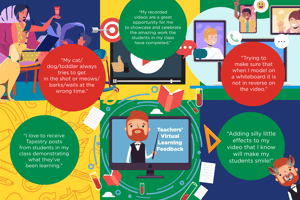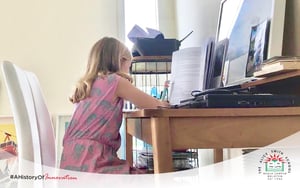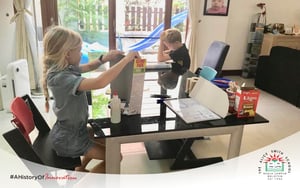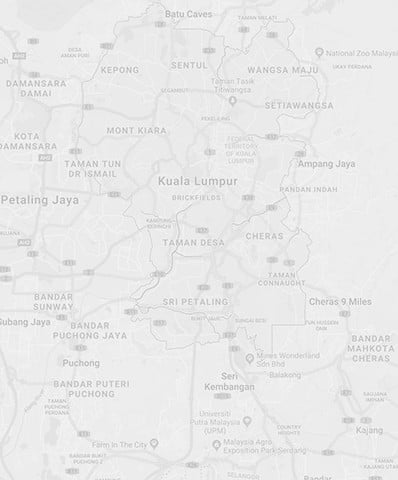
Primary school teachers at The Alice Smith School in Kuala Lumpur are learning new skills daily to provide the best distance learning programme possible for students in these challenging circumstances.
While older students in Secondary school are enjoying a full virtual timetable, ensuring the outstanding learning and teaching continues for our younger students needs a different approach.
Our Primary school teachers use the following six considerations to plan their distance learning:
Daily Teacher Presence
Daily teacher presence is maximised whilst aiming to minimise the amount of screen-time for student and staff health, safety and well being. This is done by:
- Personalised morning videos or meetings conducted by all our class teachers to motivate, celebrate and explain daily expectations
- Weekly live lessons as appropriate to age and technology access
- Additional staff for students needing support or extension
- Visual explanations created by our teachers across subject areas. These explain tasks and concepts and address misconceptions.
- Individual feedback from teacher to child daily from 9 am - 3 pm
- Story videos and assemblies at the end of the day
- Optional social clubs for students in Y4-6 weekly led by our staff
- Teachers on call to answer student/parent questions via email or in ‘drop-in’ Zoom slots between 8 am - 3 pm daily.

Considering Home Restrictions
Teachers plan lessons for their students bearing in mind that every child has a different amount of adult support, access to internet or computers, physical resources, English language, siblings etc. The considerations include:
- A daily timetable that provides both structure and flexibility to support young students and multiple sibling families to manage routine
- Live lessons that are timetabled at different times across all year groups to support families with limited devices or internet
- Teachers of younger classes without 1:1 devices use more videos and ensure valuable off-line learning tasks are provided similar to in class
- Lessons are planned keeping physical resources to a minimum. Where resources are required - parents are informed in advance. Instructions may be printed off by parents to reduce screen-time
- Live lessons are provided at parent discretion. We have put maximum safety procedures in place but as a community we must all remain vigilant during times of increased internet access for young children.
Sharing Clear Task Expectations
Tasks are set in a similar way each day and are clear for parents and children.
- Teachers provide useful examples of how to carry-out and complete each task as appropriate.
- Written explanations are clear and child friendly language used
- A rough time frame is stated for each activity
- The amount of screentime is stated and minimised.
- Short video models or photo examples are used to demonstrate how to carry out and record a task
- It is clear when an activity is optional or an expected challenge for quick finishers
Providing Explicit Learning Aims
All tasks set are paired with a clear learning objective or aim which explains what the children are learning during each activity.
- A few points are listed to show students and parents what it might look like if a child has met the aims.
- Learning activities are fluid and planned based on teacher reflection of children’s needs each day
- SEN/EAL objectives may be different - these should be linked by the name of the teacher
- Teachers meet weekly online with teaching teams to discuss tasks, moderate work and decide future learning aims.

Engaging Students
Lessons are planned by primary specialist teachers. They know each individual child and design lessons daily to meet their needs, abilities and interests.
- Lessons are varied, interesting and developmentally appropriate for each year group. Teachers plan straightforward but engaging lesson activities across the whole curriculum
- Teachers plan lessons to diversify the types of thinking and range of vocabulary that children may not be exposed at home
- Different tasks may be set for different students
- The number of students in live lessons has been set as appropriate to the age of the students and for maximum engagement levels
- Teachers provide daily praise and next steps for individuals
Providing Quality Feedback
Teachers receive work from each student daily. They analyse this against the learning aim set for each task and provide specific feedback to individuals. They know what they have learnt previously, what they need to learn next and they are carefully tracking each child’s progress.
- Teacher feedback refers to the learning intention and success criteria
- Feedback is given in a timely manner for maximum impact on learning and morale
- Teachers feedback by most appropriate methods including during live lessons, responding to email, within videos, on Google Classroom, on Tapestry, writing directly onto student work etc.
- Feedback is built into next day’s video/morning meeting to reinforce key learning intentions and to address any common misconceptions
- Online games selected also provide instant feedback to students.
- Time for self-marking and responding to teacher feedback is built into timetables as appropriate
If you'd like to find out more about what a day in the life of one of our teachers looks like during the MCO read our blog here for more insight.



